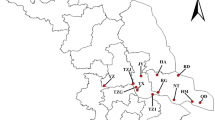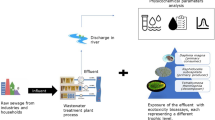Abstract
Background, aim and scope
Toxicity testing has become a suitable tool for wastewater evaluation included in several reference documents on best available techniques of the Integrated Pollution Prevention and Control (IPPC) Directive. The IPPC Directive requires that for direct dischargers as well as for indirect dischargers, the same best available techniques should be applied. Within the study, the whole effluent assessment approach of OSPAR has been applied for determining persistent toxicity of indirectly discharged wastewater from the metal surface treatment industry.
Materials and methods
Twenty wastewater samples from the printed circuit board and electroplating industries which indirectly discharged their wastewater to municipal wastewater treatment plants (WWTP) have been considered in the study. In all factories, the wastewater partial flows were separated in collecting tanks and physicochemically treated in-house. For assessing the behaviour of the wastewater samples in WWTPs, all samples were biologically pretreated for 7 days in the Zahn–Wellens test before ecotoxicity testing. Thus, persistent toxicity could be discriminated from non-persistent toxicity caused, e.g. by ammonium or readily biodegradable compounds. The fish egg test with Danio rerio, the Daphnia magna acute toxicity test, the algae test with Desmodesmus subspicatus, the Vibrio fischeri assay and the plant growth test with Lemna minor have been applied. All tests have been carried out according to well-established DIN or ISO standards and the lowest ineffective dilution (LID) concept. Additionally, genotoxicity was tested in the umu assay. The potential bioaccumulating substances (PBS) were determined by solid-phase micro-extraction and referred to the reference compound 2,3-dimethylnaphthalene.
Results
The chemical oxygen demand (COD) and total organic carbon (TOC) values of the effluents were in the range of 30–2,850 mg L−1 (COD) and 2–614 mg L−1 (TOC). With respect to the metal concentrations, all samples were not heavily polluted. The maximum conductivity of the samples was 43,700 µS cm−1 and indicates that salts might contribute to the overall toxicity. Half of the wastewater samples proved to be biologically well treatable in the Zahn–Wellens test with COD elimination above 80%, whilst the others were insufficiently biodegraded (COD elimination 28–74%). After the pretreatment in the Zahn–Wellens test, wastewater samples from four (out of ten) companies were extremely ecotoxic especially to algae (maximum LIDA = 16,384). Three wastewater samples were genotoxic in the umu test. Applying the rules for salt correction of test results as allowed in the German Wastewater Ordinance, only a small part of toxicity could be attributed to salts. Considering the PBS, wastewater from the metal surface treatment industry exhibited very low levels of PBS. In one factory, the origin of ecotoxicity has been attributed to the organosulphide dimethyldithiocarbamate (DMDTC) used as a water treatment chemical for metal precipitation. The assumption based on rough calculation of input of the organosulphide into the wastewater was confirmed in practice by testing its ecotoxicity at the corresponding dilution ratio after pretreatment in the Zahn–Wellens test. Whilst the COD elimination of DMDTC was only 32% in 7 days, the pretreated sample exhibited a high ecotoxicity to algae (LIDA = 1,536) and luminescent bacteria (LIDlb = 256).
Discussion
Comparative data from wastewater surveillance by authorities (data from 1993 to 2007) confirmed the range of ecotoxicity observed in the study. Whilst wastewater from the metal surface treatment industry usually did not exhibit ecotoxicity (median LID 1–2), the maximum LID values reported for the algae, daphnia and luminescent bacteria tests were very high (LIDA up to 3,072, LIDD up to 512 and LIDlb up to 2,048). DMDTC was found to be one important source of ecotoxicity in galvanic wastewater. DMDTC is added in surplus, and according to the supplier, the amount in excess should be detoxified with ferric chloride or iron sulphate. The operator of one electroplating company had not envisaged a separate treatment of the organosulphide wastewater but was assuming that excess organosulphide would be bound by other heavy metals in the sewer. DMDTC degrades via hydrolysis to carbon disulfide (which is also toxic to animals and aquatic organisms), carbonyl sulphide, hydrogen sulphide and dimethylamine, but forms complexes with metals which stabilise the compound with respect to transformation. Although no impact on the WWTP is expected, the question arises whether the organosulphide is completely degraded during the passage of the WWTP.
Conclusions and recommendations
The results show that the organic load of wastewater from the electroplating industry has been underestimated by focussing on inorganic parameters such heavy metals, sulphide, cyanide, etc. Bioassays are a suitable tool for assessing the ecotoxicological relevance of these complex organic mixtures. The proof of biodegradability of the organic load (and its toxicity) can be provided by the Zahn–Wellens test. The environmental safety of water treatment chemicals should be better considered. The combination of the Zahn–Wellens test followed by the performance of ecotoxicity tests turned out to be a cost-efficient suitable instrument for the evaluation of indirect dischargers and considers the requirements of the IPPC Directive.



Similar content being viewed by others
References
Achternbosch M, Brune D (1996) Stoffströme bei der Herstellung von Leiterplatten. Institut für Technikfolgenabschätzung und Systemanalyse, Forschungszentrum Karlsruhe, Technik und Umwelt, Wissenschaftliche Berichte FZKA 5854. http://www.ubka.uni-karlsruhe.de/volltexte/fzk/5854/5854.pdf
Anonymous (2005) Einsatz von Organosulfiden zur Abwasserbehandlung. Bayerisches Landesamt für Wasserwirtschaft, Referat 35, Merkblatt Nr. 4.5/13, Stand: 25.07.2005. http://www.lfu.bayern.de/wasser/fachinformationen/merkblattsammlung/teil4_oberirdische_gewaesser/doc/nr_4513.pdf
Anonymous (2008) Branchenanalyse der deutschen Galvano-und Oberflächentechnik. SOFIA, Ökopol GmbH, Zentralverband Oberflächentechnik e. V. (ZVO). www.reach-helpdesk.info/fileadmin/reach/dokumente/Anhang01Branchenanalyse.pdf
Diehl K, Hagendorf U (1998) Sammlung Biotests. Umweltbundesamt Berlin, UBA-Texte 9/98
Diehl K, Bütow E, Hussels U (2003) Erhebung von Biotestdaten des Zeitraumes 1997–2000 als ein wesentliches Element der Ableitung ordnungsrechtlicher Vorgaben. Umweltbundesamt Berlin, UBA-Texte 81/03
European Commission (2003) Reference document on best available techniques for the tanning of hides and skin. Integrated Pollution Prevention and Control (IPPC), Sevilla, February 2003. http://www.bvt.umweltbundesamt.de/archiv-e/tanningbref-e.pdf
European Commission (2006) Reference document on best available techniques in the surface treatment of metals and plastics. Integrated Pollution Prevention and Control (IPPC), Sevilla, August 2006. http://eippcb.jrc.ec.europa.eu/pages/FActivities.htm
Gartiser S, Meyer M, Jäger I (1997) Abbau ökotoxischer und mutagener Abwasserinhaltsstoffe im Zahn–Wellens-test und Labor-bzw. technischen Kläranlagen. gwf-Wasser 138:28–34
Gartiser S, Hafner C, Hercher C, Kronenberger-Schäfer K (2008) Branchenbezogene Wirktestdaten für die Neukonzipierung der Abwasserverordnung. Abschlussbericht Forschungsvorhaben Nr. 206 26 302 im Auftrag des Umweltbundesamtes, September 2008
Gartiser S, Hafner C, Oeking S, Paschke A (2009) Results of a “whole effluent assessment” study from different industrial sectors in Germany according to OSPAR’s WEA strategy. J Environ Monit 11(2):359–369
Horvat T, Vidaković-Cifrek Z, Oreščanin V, Tkalec M, Pevalek-Kozlina B (2007) Toxicity assessment of heavy metal mixtures by Lemna minor L. Sci Total Environ 384(1–3):229–238
IUCLID (2000) IUCLD data set sodium dimethyldithiocarbamate (CAS 129-04-1). European Commission, European Chemicals Bureau
OSPAR Hazardous Substances Committee (2005) Whole effluent assessment report including (a) Justification note: Whole Effluent Assessment (WEA) within OSPAR, (b) OSPAR practical study programme 2003 (c) Degradability and liability to bioaccumulate—methods used in whole effluent assessment Report 219. http://www.ospar.org/documents/dbase/publications/p00219_WEA%20report.pdf
Rether A (2002) Entwicklung und Charakterisierung wasserlöslicher Benzoylthioharnstofffunktionalisierter Polymere zur selektiven Abtrennung von Schwermetallionen aus Abwässern und Prozesslösungen, Dissertation an der Technischen Universität München. http://deposit.ddb.de/cgi-bin/dokserv?idn=964337215&dok_var=d1&dok_ext=pdf&filename=964337215.pdf
Sarakinos HC, Bermingham N, White PA, Rasmussen JB (2000) Correspondence between whole effluent toxicity and the presence of priority substances in complex industrial effluents. Environ Toxicol Chem 19(1):63–71
Schumann H, Obst K, Friedrich C, Pattard M, Pluta HJ, Hahn J (1997) Umweltverträglichkeit von Chemikalien zur Abwasserbehandlung. Umweltbundesamt UBA-Text 39/97
Weissmahr K, Sedlak DL (2000) Effect of metal complexation on the degradation of dithiocarbamate fungicides. Environ Toxicol Chem 19(4):820–826
WHO (2005) Carbon disulfide. International Chemical Assessment Document 46, World Health Organization, Geneva, 2002 (Corrigenda 2005). http://www.who.int/ipcs/publications/cicad/cicad46_rev_1.pdf
Acknowledgement
The authors thank Ms. Andrea Brunswik-Titze, Ms. Yvonne Ziser, Ms. Svetlana Lamert (Hydrotox) for the performance of ecotoxicity tests and Mr. Uwe Schröter, Ms. Susann Arnold and Ms. Maria Höher (UFZ Leipzig) for the PBS determination. We kindly acknowledge the financial support of the investigations by the German Federal Environmental Protection Agency (UBA) within the project FKZ 206 26 302 and dedicate this paper to the commemoration of Ms. Monika Pattard as expert advisor from the UBA.
Author information
Authors and Affiliations
Corresponding author
Additional information
Responsible editor: Thomas Braunbeck
Preamble. A whole effluent assessment (WEA) of two industrial sectors has been applied according to the OSPAR WEA Guidance document. Part 1 describes the testing strategy and methods used as well as the results obtained with wastewater from 13 paper mills in Germany, part 2 the results obtained with wastewater from two areas of the metal surface treatment industry (two printed circuit board and eight electroplating factories). Further investigations concerning the potential origin of elevated ecotoxicity observed in some samples are presented.
Rights and permissions
About this article
Cite this article
Gartiser, S., Hafner, C., Hercher, C. et al. Whole effluent assessment of industrial wastewater for determination of BAT compliance. Part 2: metal surface treatment industry. Environ Sci Pollut Res 17, 1149–1157 (2010). https://doi.org/10.1007/s11356-009-0290-6
Received:
Accepted:
Published:
Issue Date:
DOI: https://doi.org/10.1007/s11356-009-0290-6
Keywords
- Wastewater ordinance
- Metal surface treatment
- Printed circuit board industry
- Electroplating industry
- Ecotoxicity
- Genotoxicity
- Algae test
- Vibrio fischeri assay
- Daphnia test
- umuC assay
- Fish egg test
- Lemna test
- Zahn–Wellens test
- Potential bioaccumulating substances
- Organosulphides
- Dimethyldithiocarbamate
- Whole effluent assessment
- WEA
- OSPAR




